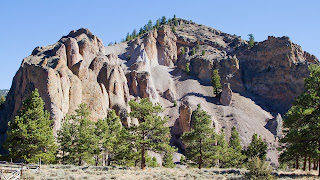The town of Lake City was incorporated in 1873 after gold was discovered in the surrounding mountains. Relatively easy transportation into the town, first by road and later by railroad, made it a natural supply center for goods into the area and ore out of the area. The mining boom raised the population up to nearly 5000 at one time, but it didn't last long. After the boom played out, the population fell to its current level of just under 500, and the main industry is now tourism. The quaint Victorian style buildings have been nicely maintained.
This late in the year, most businesses have shut down. Only one restaurant was open for lunch, the Packer Saloon. The original owner was a Green Bay Packers fan, but the name also refers to one Alferd Packer, the town's most infamous resident. Packer led a team of five miners into the mountains in 1875, where they became trapped by a blizzard. In the spring, he was the only one to come out, claiming he had been abandoned by the miners. Their bodies, however, showed evidence of cannibalism. Packer was tried, convicted and spent time in prison.
You'll notice the Packer Saloon advertises the "Cannibal Grill". Even more ghoulish, Lake City holds an annual Packer Day Barbecue.
One of the major attractions in Lake City is Lake San Cristobal, the second largest natural lake in Colorado. The lake was created when a major earthslide occurred more than 800 years ago, damming the Lake Fork Gunnison and creating the lake. The movement of earth is still occurring, sliding about twenty feet each year, making a gradual incursion into the lake. Some of the lake front homes may not be on the shore forever.




























No comments:
Post a Comment